Is Rice Gluten Free? Safe Options and The Types to Avoid
If you’re wondering “is rice gluten free?” you will find all the answers and alternatives thanks to this detailed guide. Whether you’re new to the gluten free lifestyle, or a seasoned pro it’s time to get clued up on all rice varieties and how to enjoy this beloved grain as part of your diet.
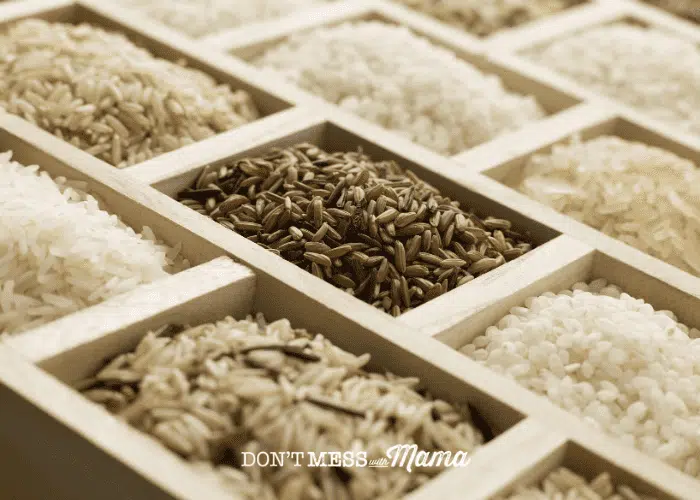
This post contains affiliate links. Please read my affiliate disclosure.
Is rice gluten-free? Short answer: Yes, rice is naturally gluten free. But if using packaged rice from a box or freezer pre-packaged meal, it could have gluten and other allergens.
Whether you’re thinking of switching your family to a gluten free diet or you’re struggling with a new intolerance, it can be common to question if our favorite foods are “safe” to eat. I’ve been there countless times over the years – from scouring food labels to quizzing staff at my favorite restaurants.
Gluten, a protein found in wheat, barley, and rye, is off-limits for those with celiac disease or gluten sensitivity. This has led many of us to scrutinize our food choices, plan more carefully, and do thorough research.
In this guide, I’ll go over the types of rice, brands I recommend, and how to avoid rice that may potentially contain gluten.
Most Common Varieties of Rice
There are thousands of types of rice, but here are the most popular that you’re likely to come across:
- White Rice: White rice is the most commonly consumed type of rice. It has had the bran and germ removed, leaving the starchy endosperm. It has a mild flavor and a soft, fluffy texture when cooked, making the perfect base for my Easy Ahi Tuna Poke Bowl. I also particularly love adding it to soups to make the recipes more fulfilling, such as my Instant Pot Stuffed Pepper Soup.
- Brown Rice: Brown rice retains the bran layer and germ, making it a whole grain. It has a nuttier flavor and a chewier texture compared to white rice. It also has a higher fiber content than white rice.
- Basmati Rice: Basmati rice is a fragrant, long-grain rice known for its distinct aroma and flavor. It is commonly used in Indian and Middle Eastern cuisines.
- Jasmine Rice: Jasmine rice is another fragrant long-grain rice with a subtle floral aroma. It is often used in Thai and Southeast Asian dishes.
- Sushi Rice: Sushi rice, also known as shari or sumeshi, is a short-grain rice specifically used in sushi preparation. It is sticky when cooked, ideal for shaping sushi rolls and nigiri.
- Black Rice: Also known as forbidden rice, black rice is a whole grain rice with a dark purple-black color. It has a nutty flavor and is rich in antioxidants.
- Red Rice: Red rice is another whole grain rice variety with a reddish-brown bran layer. It has a nutty flavor and a slightly chewy texture.
- Wild Rice: Fun fact: wild rice is not actually true rice. It is the seed of an aquatic grass. It has a unique, earthy flavor and is often used in salads and as a side dish.
- Arborio Rice/Carnaroli: These are used for making risotto. Carnaroli has a higher starch content than Arborio rice, resulting in a creamier texture but I prefer to use arborio in my Instant Pot Risotto.
- Bomba Rice: Bomba rice is a short-grain rice primarily used in paella. It absorbs liquid well, making it ideal for absorbing the flavors of the dish.
- Puffed rice: This type of rice has been processed through a method called “puffing” or “expanding.” It involves heating rice kernels under high pressure until they pop or puff up. It’s typically dry and crisp, with a slightly nutty flavor. It is often used in breakfast cereals, snack bars or sweet treats like my Chocolate Peanut Butter Puffed Rice Bars which are a delicious gluten free treat.
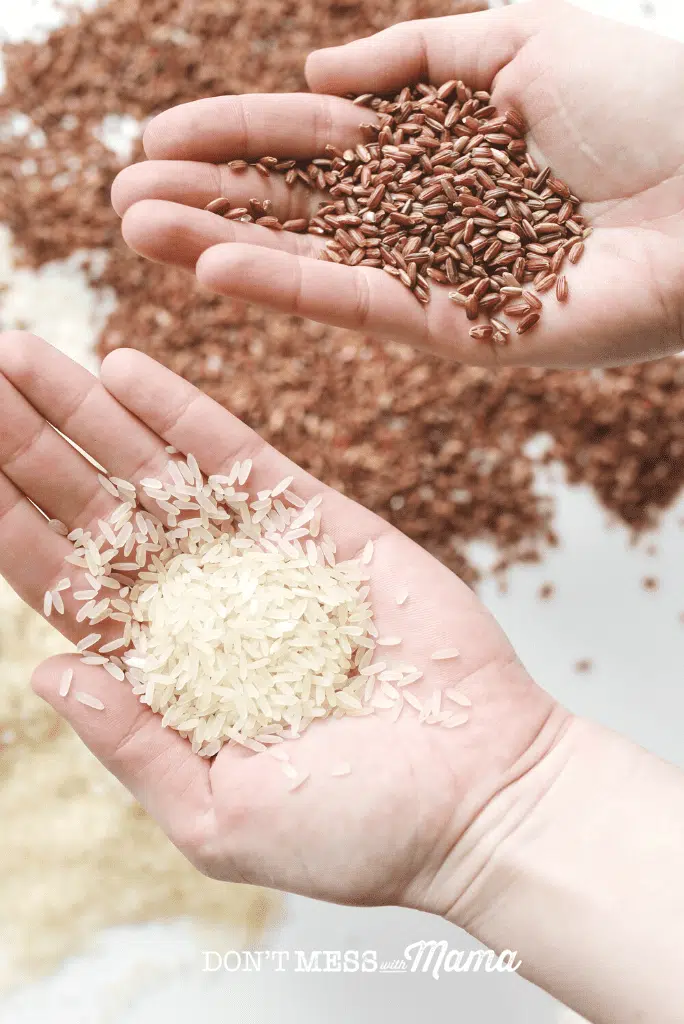
What Do Different Types of Rice Mean?
As well as the many varieties, rice can then be categorized into five types. This will help you decide which variety is best for your desired dish:
- Short grain: This rice is short and plump, typically more rounded. It gets sticky when cooked making it ideal for sushi, rice pudding and risotto.
- Medium grain: Grains are slightly shorter and wider than long grain rice, making them more rounded looking. Ideal for paella and various Asian dishes thanks to its slightly sticky texture.
- Long grain: Elongated grains that are about four times longer than they are wide. It cooks up fluffy and separates so is ideal for pilafs, fried rice or as a typical side dish.
- Whole grain: Also called brown rice, it retains the bran, germ, and endosperm layers, giving it a brown color and a nuttier flavor compared to white rice. It’s higher in fiber so is a healthier alternative for salads or savory dishes.
- Refined: Also known as white rice because the bran and germ layers have been removed during milling. It is the most common type of rice as it has a neutral flavor and a light, fluffy texture when cooked.
My Favorite Type of Rice
I’ve only just scratched the surface on rice varieties in my list above, but if I had to choose a favorite type of rice I’d say short or medium grain. I typically cook gluten free Asian dishes, so prefer the stickiness of short (sushi rice) or medium rice (known as calrose). These varieties are easy to find at grocery stores, health food stores, and Asian markets.

Is All Rice Gluten-Free?
Yes, all rice – white, brown or wild – is naturally gluten-free. Rice is a cereal grain that does not contain the proteins gliadin and glutenin, which are responsible for the gluten found in wheat, barley, rye, and their related grains.
This means, rice (in its pure and natural form) is considered a safe and gluten-free food.1 The absence of gluten makes rice a suitable option for individuals with celiac disease, gluten sensitivities, and those who choose to follow a gluten-free diet.
Despite this good news, it is still essential to be cautious when consuming rice-based products or dishes. For example, rice pilaf is often made using orzo, which does contain gluten. Rice Krispies cereal is made using malt which is not gluten-free and some rice dishes are seasoned with soy, which again contains gluten.
I also recommend being particularly careful when purchasing packaged or boxed rice. If the rice is handled or packaged in a factory where wheat, barley, rye or other gluten grains are also processed, cross contamination is a risk. Especially if the machinery is not properly cleaned.
I still only choose rice and rice products that are certified gluten-free, especially when purchasing processed or packaged items. This certification ensures the food I buy meets strict gluten-free standards and has undergone testing to confirm its safe to enjoy as part of a gluten-free lifestyle.
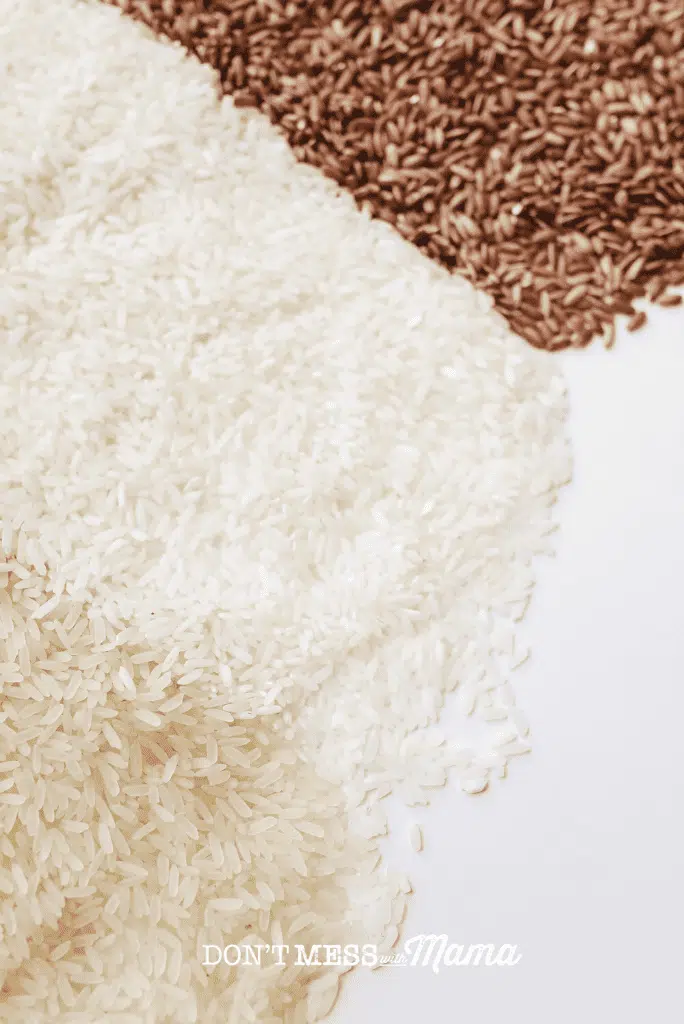
What Brands of Rice are Gluten Free?
When it comes to boxed rice products, it’s crucial to check the ingredient labels and allergen information on the specific product you’re considering. This is because formulations can vary by brand and product type.
Here are some popular rice brands that offer gluten free rice varieties:
- Uncle Ben’s: Probably one of the most well known boxed rice brands, Uncle Ben’s offers a range of rice products, including some that are naturally gluten-free, like their plain white and brown rice. However, be cautious when considering flavored rice products, as they may have gluten-containing ingredients in the seasoning packets.
- Rice-A-Roni: Rice-A-Roni is known for its flavored rice and pasta blends. While they have some gluten-free options, such as their Long Grain & Wild Rice Mix, I want to reiterate the importance of reading food labels carefully. While some of their products will explicitly state gluten-free, others may contain wheat.
- Minute Rice: Many of Minute Rice’s plain rice products (like their Instant White Rice and Instant Brown Rice) are naturally gluten-free. However, cross contamination warnings may pop up from time to time on packaging so always read the label before throwing some in your cart.
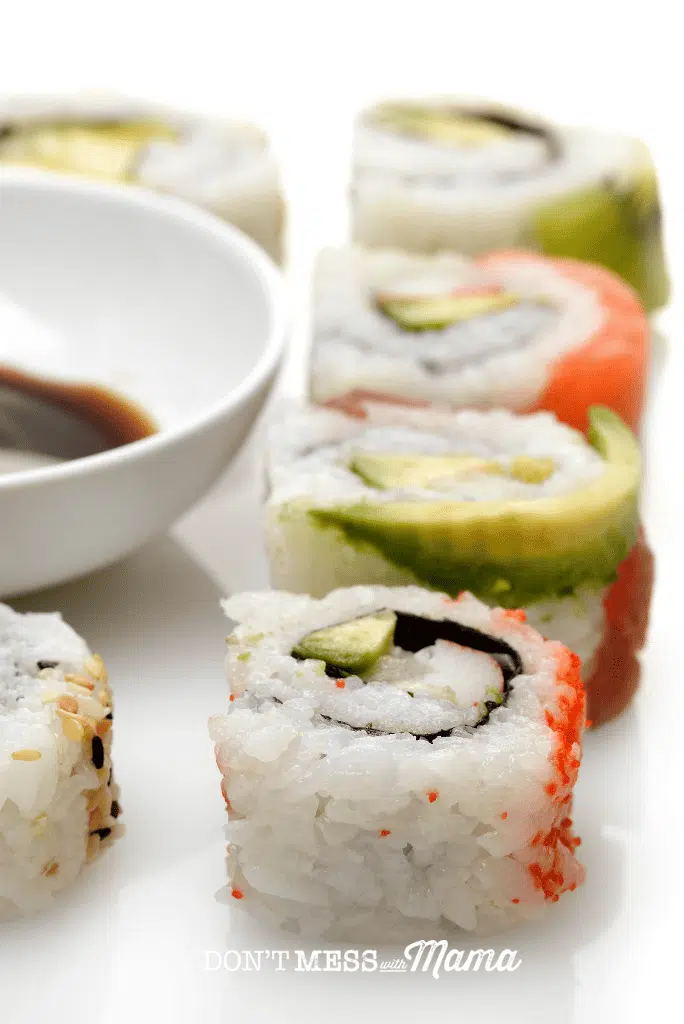
GMO Free Rice
As well as gluten-free, I also like to ensure the rice I buy is GMO free. “GMO-free rice” refers to rice that has not been genetically modified (GM) through the use of genetic engineering techniques.
This is when farmers introduce genes from other organisms (such as bacteria) so the rice has certain traits such as resistance to pests or tolerance to herbicides. I prefer GMO-free rice as there are concerns about the potential health and environmental impacts of Genetically Modified Organisms.
To ensure that rice is GMO-free, look for products with certifications or labels indicating non-GMO status. Alternatively, purchase your rice from a trusted source that is open about their agricultural practices. For example:
- Lundberg Family Farms: Lundberg is known for its organic and non-GMO rice varieties, including options like organic brown rice and organic wild rice.
- Nature’s Earthly Choice: This brand offers a selection of gluten-free rice products, including organic and non-GMO rice.
- Bob’s Red Mill: Primarily known for flours and grains, Bob’s Red Mill also offers gluten-free rice products like white rice flour and whole grain brown rice flour.
Is Rice Flour Gluten-Free?
Yes, rice flour is naturally gluten-free. It is a safe and versatile option for those following a gluten-free diet. It’s made by grinding rice grains into a fine powder and is commonly used in gluten-free baking, cooking, and as a thickening agent.
I use it in my own Homemade All-Purpose Flour recipe which I love to use for baking my own Gluten Free Bread. I’ve found this much cheaper than buying from the store and I can limit any cross contamination risk baking in my own kitchen.
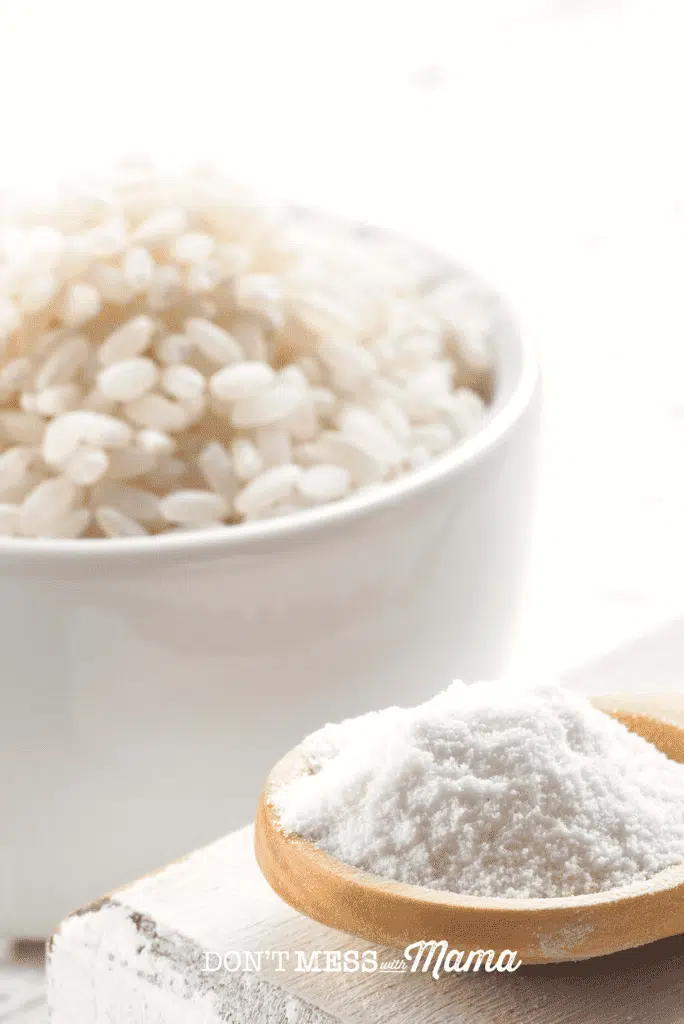
Is Brown Rice Gluten Free?
Absolutely, brown rice is gluten-free. It’s a whole grain rice that retains its bran layer, which is packed with nutrients and fiber. This means it’s an excellent choice for those with gluten sensitivities or celiac disease who need a good source of fiber in their diet.
Is Jasmine Rice Gluten Free?
Yes, jasmine rice is naturally gluten-free. This fragrant and aromatic rice variety is particularly popular in many Asian dishes and poses no risk for individuals avoiding gluten.
Is Wild Rice Gluten Free?
Wild rice is another gluten-free grain. Confusingly, it is actually a type of grass seed and not technically rice. It’s a nutrient-rich option and a great addition to gluten-free diets.
Is White Rice Gluten Free?
White rice is indeed gluten-free. It’s the polished version of brown rice, with the bran and germ removed. This means the nutritional value is slightly lower than brown rice however, it remains a versatile, safe, gluten-free option.
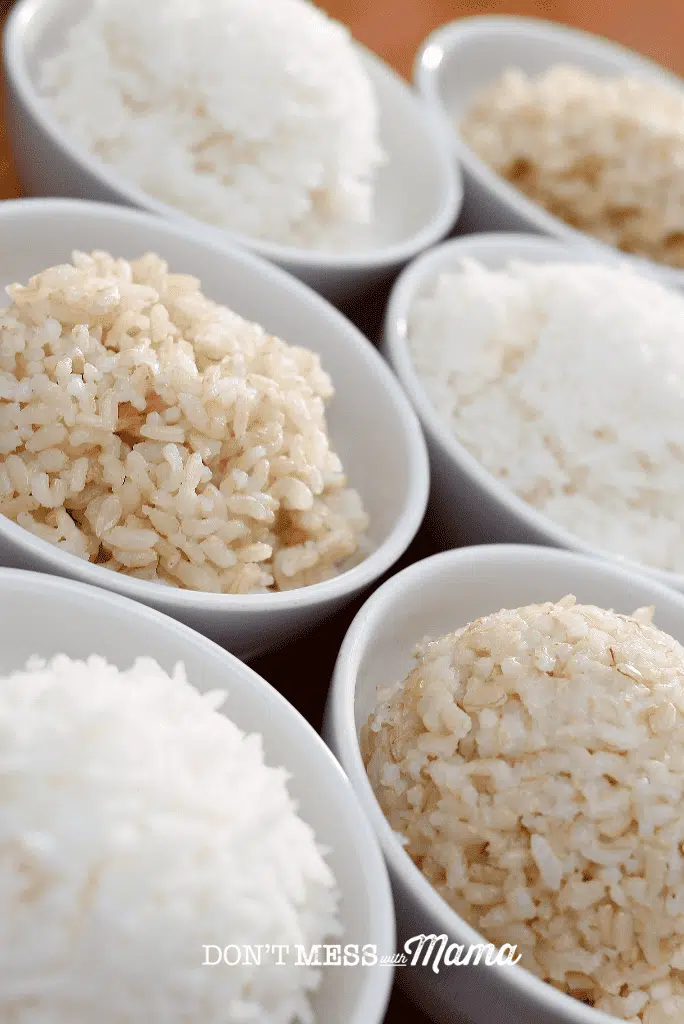
Is Basmati Rice Gluten Free?
Yes, basmati rice is gluten-free. It’s a long-grain rice known for its aromatic fragrance and is commonly used in Indian and Middle Eastern cuisines. It is perfectly safe for those with gluten sensitivities or celiac disease.
Is Rice Paper Gluten Free?
Alongside flour, rice paper is probably one of the most popular rice products. It is used for making spring rolls and is generally gluten-free. It’s made from rice flour, water, and sometimes tapioca starch. However, I always recommend you check the specific brand or product label as there may be additives or cross-contamination risks during the manufacturing process.
Is Fried Rice Gluten Free?
Not if regular soy sauce is used. Soy sauce is made with wheat flour. However, that doesn’t mean you need to miss out on your favorite foods, instead use my Soy Sauce Substitute to create Gluten Free Fried Rice.
Using Tamari – a gluten-free soy sauce instead of traditional soy sauce is one of the best gluten free swaps I’ve found. It’s the closest in taste to regular soy sauce. There’s also a no soy Tamari option too.
Some people also recommend Coconut Aminos as another gluten free option, but it’s sweeter and lighter than soy sauce. I find it’s good for dishes to make teriyaki sauce or anything with a sweeter taste (like these delicious Gluten Free Chinese Dumplings) , but for fried rice I prefer Tamari gluten-free soy sauce.
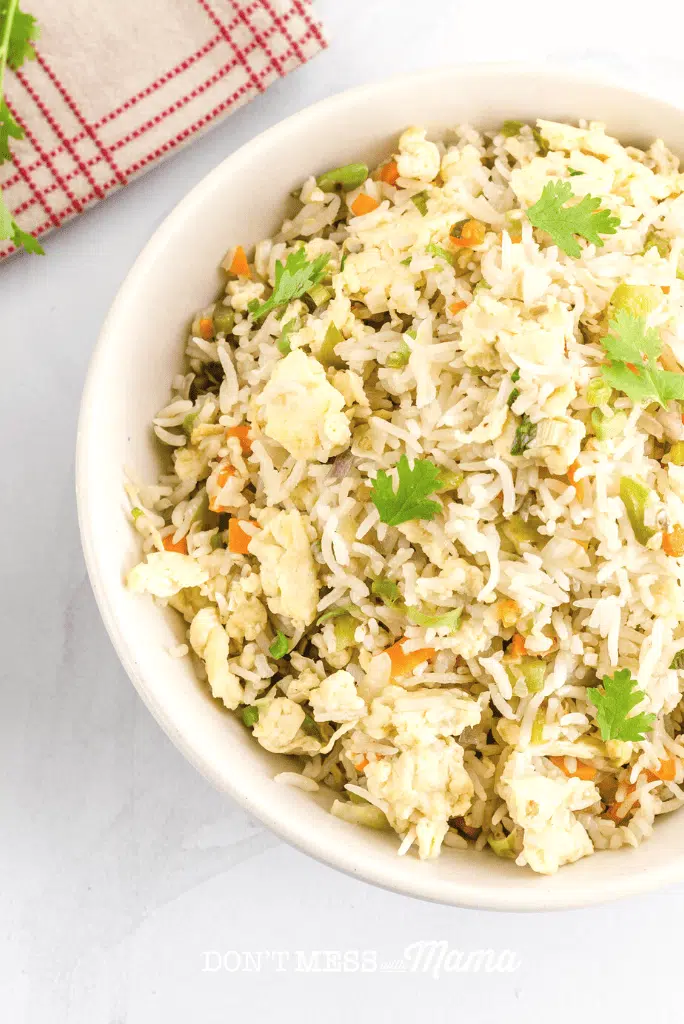
Now that you know rice is gluten free, go make your favorite dishes and enjoy it with rice. Remember,
More Posts You Might Like
- How to Make Rice Water for Your Hair
- Cauliflower Rice Recipe
- 50+ Gluten Free Mexican Recipes
- 75+ Gluten Free Freezer Meals, Sides and Snacks
Did you know if rice is gluten free? Comment below to let me know what your favorite rice dishes are. You can also FOLLOW ME on Facebook, Instagram and Pinterest to see what other fun things I’m getting up to.
Want More Recipes?
Check out my new book, Gluten-Free, Real Food Recipes for Kids.
I wrote this book with YOU in mind. Parents who want to provide kids with wholesome meals without artificial colors, preservatives and other additives.
All the recipes are gluten-free – with many options for grain free or Paleo, dairy free, egg free and vegetarian.
What’s Included In This Book
It’s filled with 130+ pages of content and recipes, including:
- Real food nutrition 101
- Detailed information on how to properly soak and sprout nuts, beans, grains and seeds
- A guide on how to spot chemical additives and what to avoid
- Kitchen essentials and cooking tools
- Tips on how to get kids to become better eaters and help in the kitchen
- 70+ gluten-free recipes – such as snacks and appetizers, beverages, condiments and dressings, main meals, desserts and more
Take a peek what’s inside Gluten-Free, Real Food Recipes for Kids.
Sources:
1. https://medlineplus.gov/ency/patientinstructions/000813.htm
2. https://www.hopkinsmedicine.org/health/conditions-and-diseases/celiac-disease/dietary-changes-for-celiac-disease
3. https://www.hsph.harvard.edu/nutritionsource/food-features/rice/

